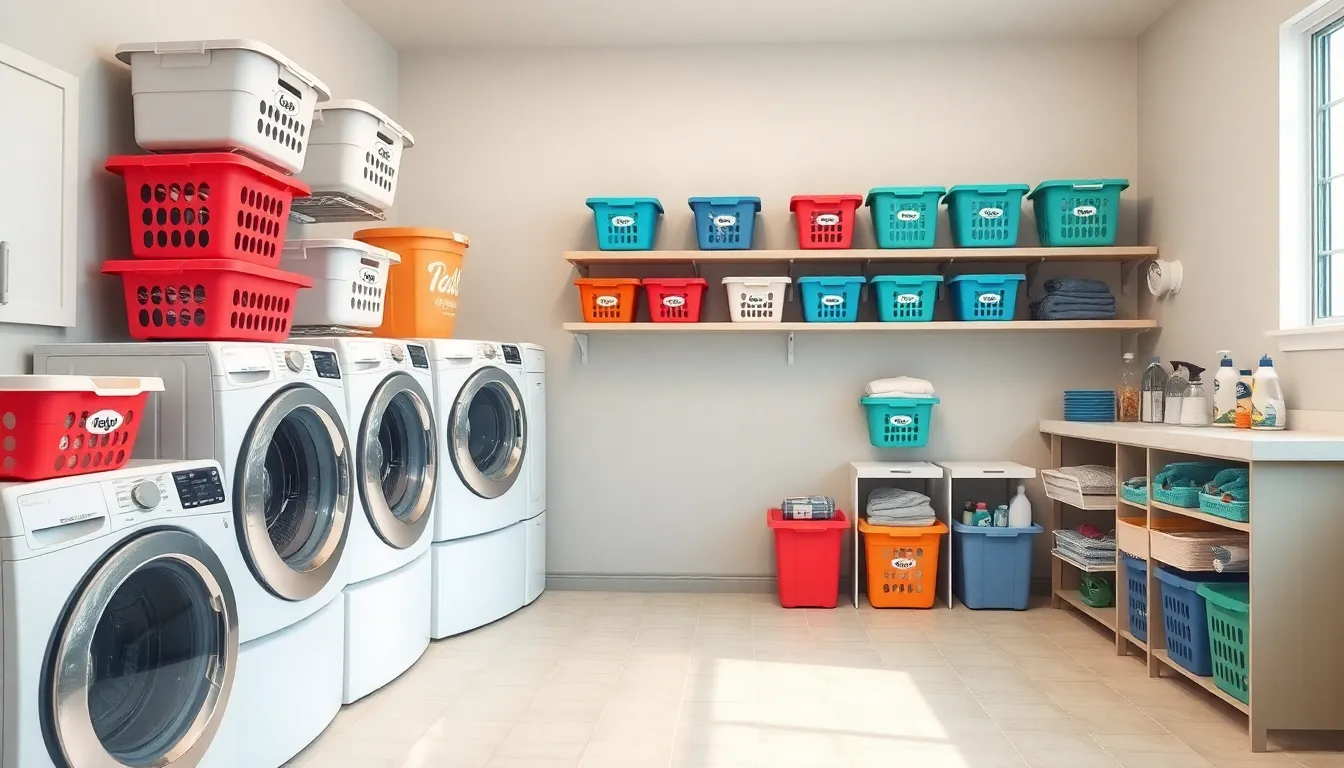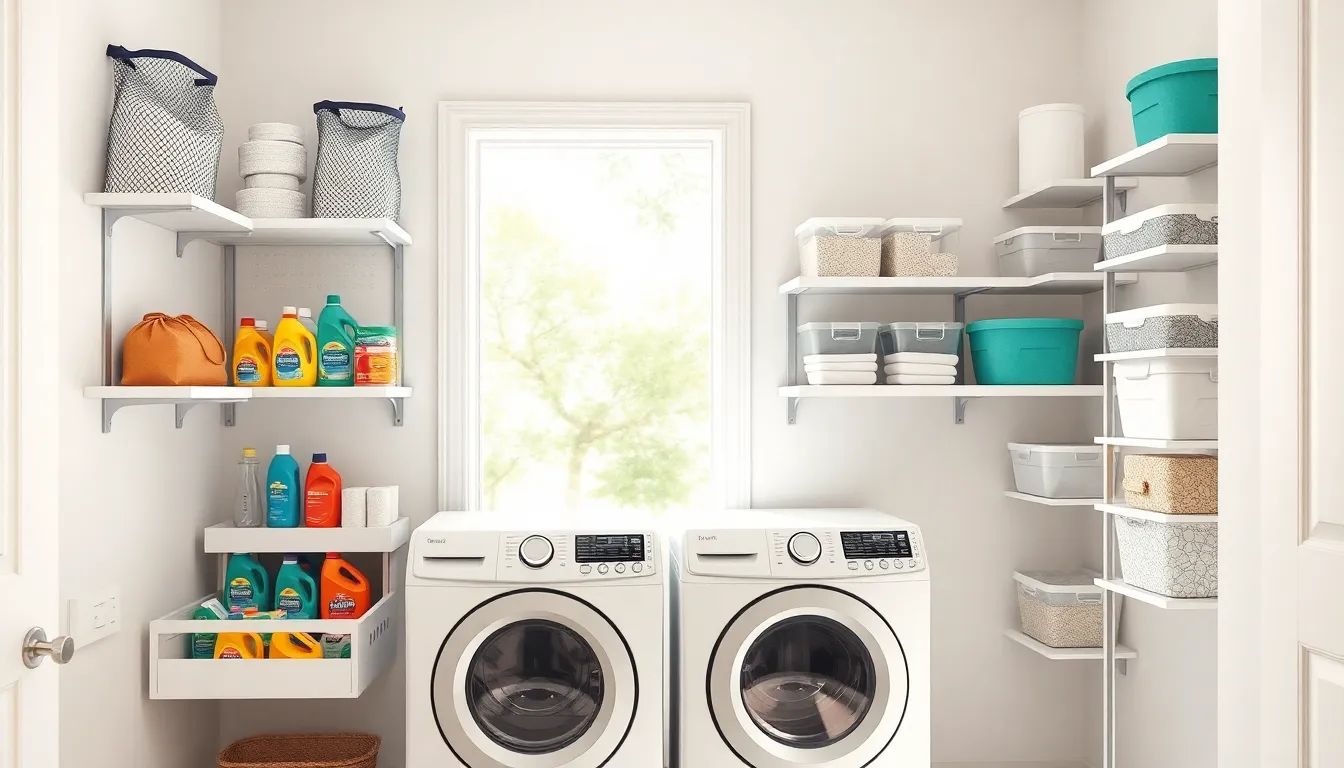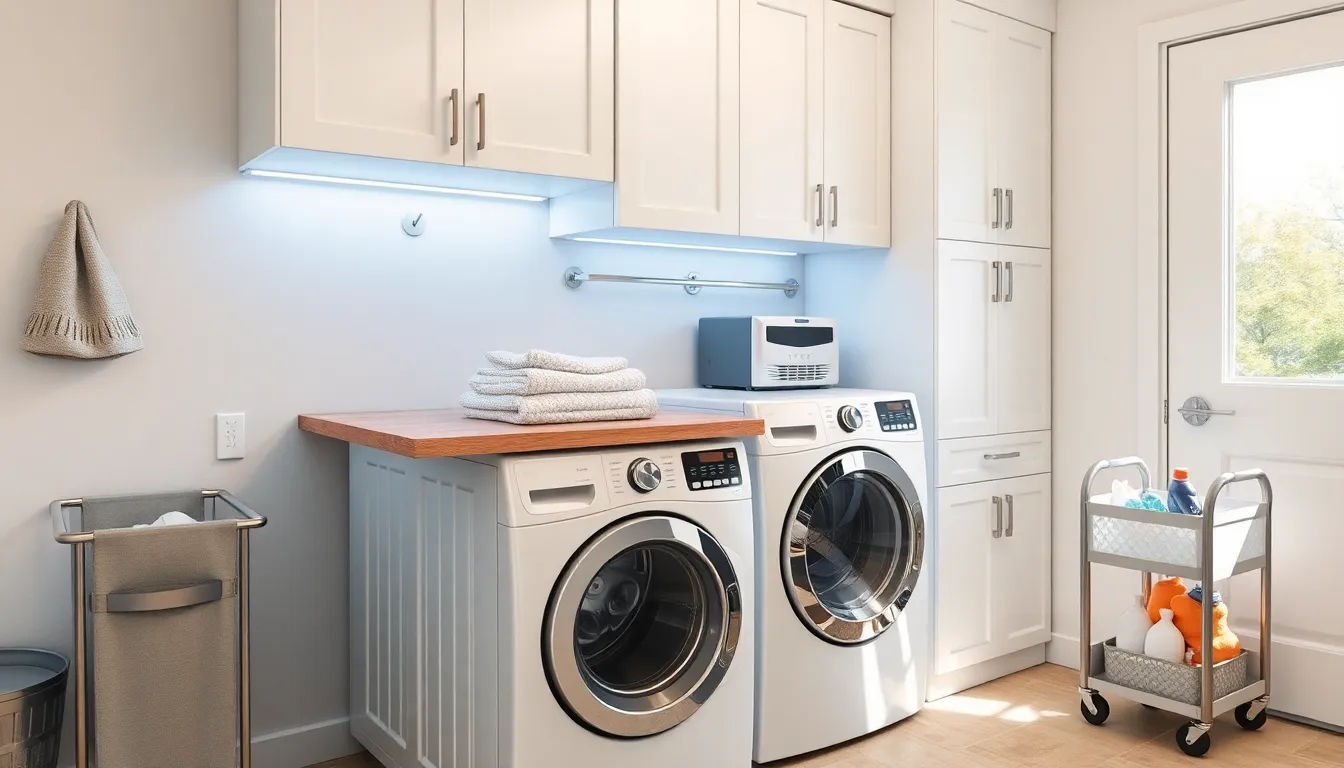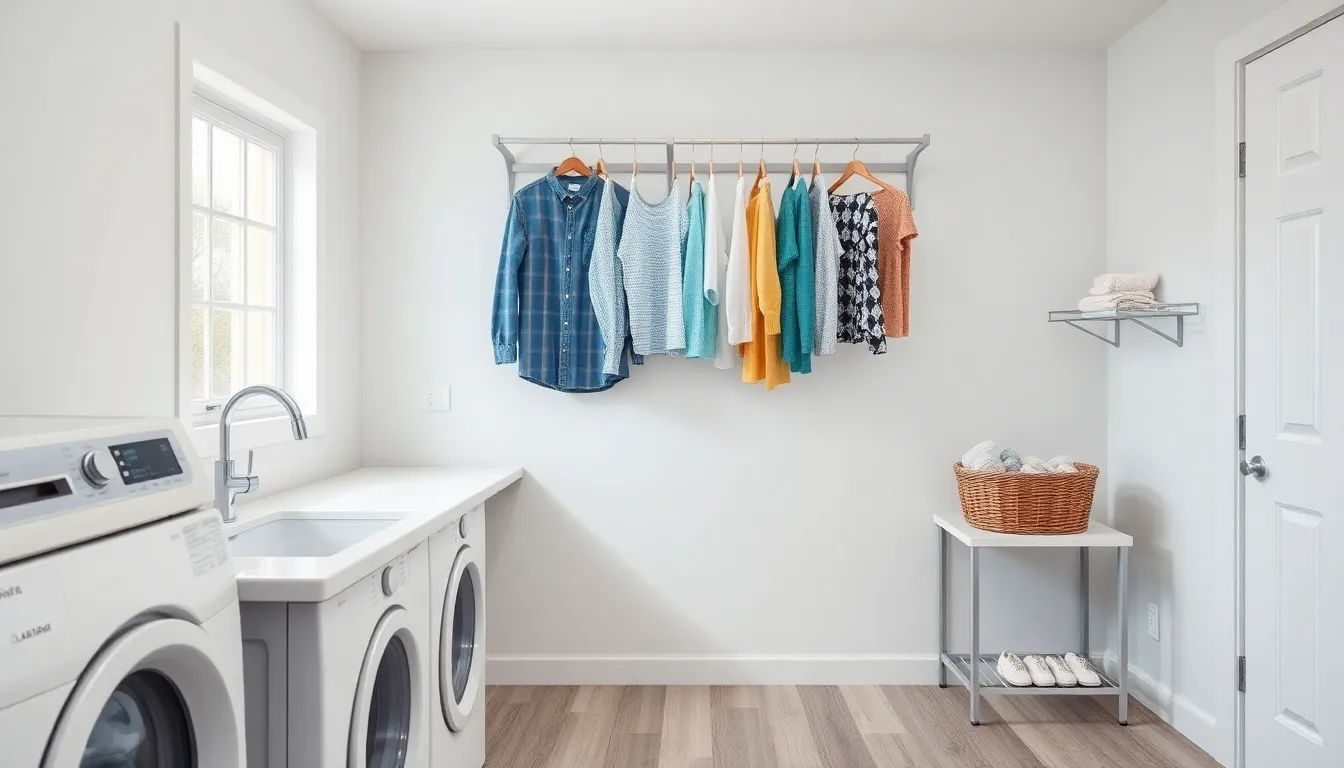A cluttered laundry room can turn washing clothes into a frustrating chore that we all dread. We’ve all been there – searching through piles of detergent bottles, wrestling with tangled hangers, and struggling to find matching socks in the chaos. But what if we told you that transforming your laundry space into an organized, efficient haven is easier than you think?
Smart laundry room organization isn’t just about making things look pretty. It’s about creating a functional workspace that saves time, reduces stress, and actually makes doing laundry enjoyable. Whether you’re working with a spacious dedicated room or a compact closet setup, the right organizational strategies can maximize every square inch.
We’ve compiled the most effective laundry room organization ideas that’ll revolutionize how you tackle this essential household task. From clever storage answers to space-saving hacks, these proven methods will help you create the organized laundry room you’ve always wanted.
Maximize Vertical Wall Space With Smart Storage Solutions
Smart vertical storage transforms your laundry room’s unused wall space into functional storage areas. We’ll show you three proven strategies that instantly double your storage capacity while keeping essentials within arm’s reach.
Install Floating Shelves Above Your Washer and Dryer
Floating shelves above your washer and dryer create instant storage for detergents, fabric softeners, and cleaning supplies. We recommend installing 2-3 shelves with 12-16 inches between each level to accommodate different container heights. Position the bottom shelf at least 18 inches above your appliances to prevent interference with opening lids.
Choose shelves that are 6-8 inches deep to hold standard laundry containers without items falling off. Install brackets directly into wall studs for maximum weight capacity of 25-30 pounds per shelf. Add adhesive shelf liners to prevent bottles from sliding and create a clean, finished appearance.
Store frequently used items like detergent and stain removers on lower shelves for easy access. Reserve upper shelves for seasonal items such as wool wash, specialty cleaners, and backup supplies you don’t need weekly.
Add Wall-Mounted Cabinets for Hidden Storage
Wall-mounted cabinets conceal clutter while maximizing your vertical storage potential. Install cabinets 12-15 inches above your countertop or folding area to maintain comfortable working height. Choose cabinets with adjustable shelves to accommodate items of various sizes.
Consider cabinets with frosted glass doors or solid fronts depending on whether you want to display or hide contents. Mount cabinets using heavy-duty wall anchors rated for 50+ pounds to support the weight of stored items. Position cabinets at eye level for items you use daily and higher for seasonal storage.
Store bulk supplies like extra detergent pods, dryer sheets, and cleaning cloths inside these cabinets. Add pull-out drawers or lazy Susans inside deeper cabinets to access items stored in the back corners easily.
Use Pegboards for Hanging Cleaning Tools
Pegboards turn any wall section into customizable tool storage that adapts to your changing needs. Install pegboards between 48-60 inches from the floor for comfortable reach while doing laundry tasks. Choose pegboards with 1/4 inch holes spaced 1 inch apart for maximum hook compatibility.
Hang brooms, mops, dusters, and spray bottles using specialized pegboard hooks and holders. Add small baskets or containers to pegboard hooks for storing clothespins, lint rollers, and stain removal pens. Create zones on your pegboard by grouping similar items together for quick identification.
Paint your pegboard to match your laundry room’s color scheme or leave it natural for an industrial look. Mount pegboards directly to wall studs or use spacer blocks to create clearance for hooks and hanging items.
Create Designated Sorting Stations for Efficient Workflow

Establishing dedicated sorting areas transforms our laundry routine from chaotic to streamlined. We’ll create separate stations for different fabric types like delicates, lights, and darks to prevent color bleeding and fabric damage.
Set Up Multiple Laundry Baskets for Pre-Sorting
Multiple laundry baskets eliminate the guesswork from our washing routine. We recommend using three to four labeled baskets positioned strategically throughout our laundry room for maximum efficiency.
Position baskets according to washing frequency:
- Heavy duty items like towels and sheets
- Everyday clothing including cottons and blends
- Delicate fabrics requiring gentle cycles
- Dark colors that need cold water settings
Rolling laundry carts work exceptionally well for families who generate large volumes of dirty clothes. We can easily wheel sorted loads directly to our washing machine without lifting heavy baskets.
Stackable sorting bins maximize floor space in smaller laundry rooms. We’ll arrange them vertically against walls or beside our washer and dryer units for convenient access.
Install Pull-Out Drawers for Easy Access
Pull-out drawers keep our laundry supplies organized while maintaining clear floor space. We’ll install these convenient storage answers to house detergent, fabric softener, and spare change within arm’s reach.
Essential drawer configurations include:
- Deep drawers for bulk detergent containers
- Shallow compartments for small items like lint rollers
- Divided sections for sorting loose change and buttons
- Slide out trays for measuring cups and scoops
Cabinet mounted pull-out systems work best beneath countertops or beside our washing machines. We can access everything without bending down or reaching into deep cabinets.
Soft close mechanisms prevent drawers from slamming shut and extend hardware lifespan. We’ll invest in quality slides that support the weight of heavy detergent bottles and cleaning supplies.
Label Everything for Family-Friendly Organization
Labels create accountability and encourage household participation in laundry organization. We’ll mark every basket, drawer, and shelf to establish clear storage expectations for family members.
Effective labeling strategies include:
- Picture labels for young children who can’t read yet
- Color coded systems matching basket colors to clothing types
- Waterproof labels that withstand laundry room humidity
- Clear fonts that remain visible from across the room
Laminated labels resist moisture damage and maintain readability over time. We’ll use a label maker or waterproof markers to ensure our organizational system stays intact.
Consistent placement helps family members develop organizational habits automatically. We’ll position labels at eye level and use the same labeling style throughout our entire laundry room for visual consistency.
Transform Dead Space Into Functional Storage Areas

Every laundry room has overlooked spaces that we can transform into valuable storage answers. These forgotten areas often hold the key to maximizing our room’s organizational potential.
Use the Gap Between Washer and Dryer
Pull-out shelves fit perfectly in the narrow space between your washer and dryer, creating instant storage for frequently used supplies. We recommend installing sliding drawers that accommodate detergent bottles, fabric softener, and stain removal products within easy reach. Rolling laundry carts work exceptionally well in this area since they provide mobility while maximizing the available floor space between appliances.
Stackable storage bins offer another solution for this tight space, allowing us to separate different types of laundry supplies vertically. Installing narrow shelving units transforms this dead zone into a functional supply station that keeps everything organized and accessible during wash cycles.
Add Shelving Above the Door Frame
Over-the-door storage racks maximize the vertical space above your laundry room entrance, keeping cleaning supplies and laundry bags within reach but out of the way. We can hang lightweight items like mesh laundry bags, lint rollers, and cleaning cloths on these convenient door mounted systems.
Floating shelves installed above the door frame create additional storage for items we don’t use daily, such as seasonal detergents or bulk supplies. These elevated storage areas work particularly well for storing fabric refreshers, dryer sheets, and other lightweight laundry essentials that would otherwise clutter our main workspace.
Convert Unused Corners Into Storage Nooks
Corner shelving units maximize these often wasted triangular spaces, providing dedicated storage for laundry detergent, fabric softener, and cleaning supplies. We can install tiered corner shelves that accommodate different sized containers while keeping everything visible and organized.
Square containers and dispensers work more efficiently than round ones in corner spaces, allowing us to store detergent, scent beads, and other laundry essentials with minimal wasted space. Rolling hampers and shelving units stocked with storage baskets fit perfectly in corners, creating mobile organization stations that we can move as needed throughout our laundry routine.
Corner baskets mounted at various heights create multiple storage zones for different categories of supplies, from everyday detergents at eye level to specialty products stored higher up.
Implement Smart Solutions for Small Laundry Rooms

Small laundry spaces require strategic planning to maximize functionality without sacrificing accessibility. We’ll transform your compact area into an efficient workspace using these proven space-saving techniques.
Choose Stackable Storage Containers
Stackable storage containers help use vertical space efficiently in cramped laundry rooms where every square inch matters. We recommend selecting clear containers so you can quickly identify contents like detergents, fabric softeners, and cleaning supplies without opening each bin. Labeled stackable bins work exceptionally well when floor space is limited, allowing you to store sorted laundry vertically rather than spreading baskets across the room.
Consider these container types for maximum organization:
- Clear plastic bins for detergent pods and fabric softener sheets
- Mesh containers for delicate items and lingerie
- Solid containers for cleaning rags and old towels
Install Fold-Down Ironing Boards
Fold-down ironing boards are designed to attach to walls or cabinet interiors, minimizing their footprint when not in use. We’ve found this feature ideal for small laundry rooms because it allows efficient garment care without sacrificing valuable floor space that you need for sorting and folding. Mounted boards remain out of the way when folded and stay protected from potential water damage or accidental bumps.
Installation typically requires basic wall anchors and takes less than 30 minutes. Choose models with heat-resistant covers and sturdy hinges that can withstand daily use.
Use Over-the-Door Organizers
Over-the-door organizers provide additional storage for small items like clothespins, lint rollers, and travel-sized detergents without requiring wall mounting or permanent installation. We suggest measuring your door width first and selecting an appropriately sized organizer to ensure a perfect fit. This solution keeps countertops and existing shelves clear for larger items like laundry baskets and folding activities.
- Wire racks with multiple compartments for cleaning supplies
- Fabric organizers with pockets for dryer sheets and stain removers
- Hook systems for hanging delicate items to air dry
Design a Dedicated Folding and Ironing Station

Creating a dedicated workspace for folding and ironing transforms your laundry routine from chaos to organized efficiency. We’ll explore three essential components that turn any laundry room into a functional processing center.
Create a Countertop Workspace Above Appliances
Installing a countertop above front-load washers and dryers provides the clean surface we need for efficient laundry processing. This workspace serves multiple purposes by offering space for folding clothes, storing laundry baskets, and organizing essential supplies within arm’s reach.
We recommend positioning the countertop 12-15 inches above your appliances to ensure comfortable working height while maintaining easy access to washer and dryer controls. The surface should extend beyond the appliance edges by at least 2 inches on each side to create adequate folding space for larger items like sheets and comforters.
Choose materials that resist moisture and stains, such as laminate or butcher block with waterproof finish. These surfaces handle daily use while providing the durability needed in high-moisture environments.
Add a Rolling Cart for Portable Organization
Rolling carts offer unmatched flexibility for storing laundry supplies while keeping essentials accessible throughout your washing routine. We position these carts to hold detergent, fabric softener, stain removers, and other frequently used items that need to move with us as we work.
The key advantage lies in portability – we can roll the cart between appliances, to the sorting station, or even to other rooms when treating stains or gathering clothes. Three-tier carts work best, allowing us to organize supplies by category: cleaning products on top, detergents in the middle, and fabric care items on the bottom.
Look for carts with locking wheels to prevent unwanted movement during use, and choose models with raised edges or bins to prevent items from falling off during transport.
Install Good Lighting for Better Visibility
Proper lighting dramatically improves our ability to identify stains, sort fabrics accurately, and navigate the laundry room safely. We need multiple light sources to eliminate shadows and provide consistent illumination across all work areas.
Overhead lighting forms the foundation, but we enhance visibility by adding under-cabinet LED strips beneath upper storage areas. These strips illuminate countertop workspaces where we fold clothes and treat stains, reducing eye strain during detailed tasks.
Task lighting becomes especially important near the folding station and appliance controls. We install adjustable LED fixtures that direct light exactly where needed, ensuring we can read care labels and identify fabric colors accurately even during evening laundry sessions.
Organize Cleaning Supplies and Detergents Safely

Storing cleaning supplies and detergents properly ensures both safety and efficiency in our laundry room. Strategic organization prevents accidents while maintaining easy access to frequently used products.
Use Clear Containers for Easy Identification
Visibility becomes crucial when we transfer products into containers that allow us to see contents at a peek. Glass or plastic clear containers work perfectly for storing detergent pods, fabric softener sheets, and scent beads where we can instantly identify what we need.
Labeling each container prevents confusion and helps every family member locate exact items quickly. We recommend using waterproof labels that won’t peel off in humid laundry room conditions.
Decanting dry products like detergent powder into square containers maximizes our storage space while reducing visual clutter from mismatched packaging. These containers stack efficiently and create a uniform appearance on our shelves.
Install Child-Safe Cabinet Locks
Safety becomes our top priority when storing hazardous cleaning chemicals and detergents in homes with children. Cabinet locks prevent accidental access to products that could cause serious harm if ingested or mishandled.
Magnetic locks offer the most secure option since they’re invisible from the outside and require a special key to open. Installation takes just minutes with adhesive backing that won’t damage our cabinet doors.
Placement of these locks should cover all lower cabinets where we store bleach, fabric softeners, and concentrated detergents. We also recommend securing upper cabinets if children can climb or reach them using stools.
Create a Spill-Proof Storage System
Dispenser bottles with tight fitting lids prevent messy spills when we handle liquid fabric softeners and bleach products. These containers make measuring easier while protecting our floors from accidental drips.
Shelf liners catch any spills before they reach our cabinet surfaces, making cleanup much simpler when accidents happen. Waterproof mats work best since they can be removed and washed when needed.
Containment trays under liquid products provide an extra layer of protection against leaks from manufacturer bottles. We position these trays on shelves where we store products most likely to drip or spill over time.
Add Functional Elements for Everyday Convenience

Strategic additions to our laundry room can transform routine tasks into effortless activities that make the entire process more convenient.
Install a Utility Sink for Hand Washing
Utility sinks prove invaluable for hand washing delicate fabrics that can’t withstand machine washing cycles. These fixtures create a dedicated space where we can gently clean silk blouses, wool sweaters, and lace undergarments without risking damage in the washing machine. Installing a utility sink provides the perfect solution for pre-treating stubborn stains on items like grass-stained sports uniforms or wine-spilled tablecloths before they enter the regular wash cycle.
Positioning the utility sink near our sorting station maximizes workflow efficiency. We’ll want to choose a deep basin model that accommodates larger items like comforters and sleeping bags when spot cleaning becomes necessary. Modern utility sinks come with pull-out spray attachments that make rinsing soap residue from delicate items incredibly easy.
Water-resistant flooring around the utility sink prevents costly damage from inevitable splashes and spills. Vinyl plank flooring or ceramic tiles work exceptionally well in these high-moisture areas, providing both durability and easy cleanup when water escapes the basin.
Add a Drying Rack for Delicate Items
Wall-mounted drying racks save valuable floor space while providing essential air-drying capabilities for delicate garments. Installing these racks above our utility sink or in an unused corner creates a dedicated drying zone that doesn’t interfere with our regular laundry workflow. These fixtures work perfectly for items like cashmere sweaters, swimwear, and lingerie that require gentle air drying.
Foldable drying racks offer exceptional flexibility for households with varying laundry volumes. We can expand these units when dealing with larger loads of delicate items like a family’s worth of workout clothes, then fold them away when floor space becomes a priority. Many models feature multiple tiers that accommodate different garment lengths from tank tops to flowing dresses.
Retractable clothesline systems provide additional drying space without permanent installation requirements. These convenient answers stretch across our laundry room when needed, then retract completely out of the way once our delicates finish drying.
Include a Lost Sock Storage Solution
Small baskets or containers strategically placed near our sorting station collect orphaned socks until their partners surface in future loads. We’ve all experienced the mysterious disappearance of single socks, and having a designated collection spot prevents these lonely items from cluttering our clean laundry piles. Clear containers work best because we can quickly identify potential matches without rummaging through the entire collection.
Hanging organizers with individual pockets attach easily to walls or the sides of our washer and dryer. These multi-pocket answers store mismatched socks along with other small laundry room essentials like stain removal pens, fabric softener sheets, and lint rollers. Each pocket can accommodate different sock sizes from children’s ankle socks to adult athletic socks.
Monthly sock matching sessions turn this organizational task into a family activity that often reveals long-lost favorites. Setting aside time to reunite separated pairs helps maintain an organized system while teaching children responsibility for their belongings.
Conclusion
We’ve covered many strategies to transform your laundry room from chaos to clarity. These organization ideas work whether you’re dealing with a spacious dedicated room or a compact closet setup.
The key is choosing answers that fit your exact needs and space constraints. Start with one or two ideas that address your biggest pain points then gradually carry out additional strategies as you see what works best for your household.
Remember that maintaining an organized laundry room requires consistent effort from everyone in the family. With proper labeling systems and designated spaces for everything you’ll find that keeping things tidy becomes second nature.
Your newly organized laundry room will save you time reduce stress and make this necessary chore much more manageable for years to come.
Frequently Asked Questions
How can I maximize storage in a small laundry room?
Focus on vertical space by installing floating shelves above your washer and dryer, using stackable storage containers, and adding over-the-door organizers. Utilize corners with tiered shelving units and consider fold-down ironing boards to save floor space. These solutions help create more storage without cluttering your limited area.
What’s the best way to organize laundry sorting?
Create designated sorting stations with labeled laundry baskets for different fabric types and colors. Use rolling carts for large volumes or stackable bins for smaller spaces. Position baskets according to washing frequency, with everyday items most accessible. This prevents color bleeding and streamlines your washing process.
How do I safely store cleaning supplies in my laundry room?
Use clear, labeled containers stored in locked cabinets away from children’s reach. Install child-safe cabinet locks and use spill-proof dispensers with tight-fitting lids. Add shelf liners and containment trays to manage potential spills. Keep hazardous materials separate from everyday supplies for maximum safety.
What storage solutions work best for the space between washer and dryer?
Install pull-out shelves or use slim rolling carts that fit in this narrow gap. These solutions provide easy access to frequently used supplies like detergent and fabric softener. Choose options with wheels for easy movement and adjustable shelves to accommodate different bottle sizes.
How can I create an efficient folding station?
Install a countertop above front-load washers and dryers at comfortable working height (36-42 inches). Add good lighting with multiple sources for visibility and use rolling carts for portable supply organization. This creates a dedicated workspace that makes folding clothes more comfortable and efficient.
What’s the purpose of labeling everything in a laundry room?
Labeling creates accountability and encourages family participation in maintaining organization. Use picture labels for children and waterproof labels for durability in humid conditions. Clear labeling helps everyone know where items belong, making it easier to maintain your organized system long-term.
How do I utilize overlooked spaces for laundry storage?
Transform gaps between appliances with pull-out shelves, use over-the-door racks for cleaning supplies, and add floating shelves above door frames. Install corner shelving units in unused corners. These often-forgotten spaces can significantly increase your storage capacity when properly utilized.
What are the essential components of a functional laundry room?
Key elements include vertical storage solutions (floating shelves, wall cabinets), designated sorting stations with labeled baskets, pull-out drawers for supplies, proper lighting, and safety features like locked storage for cleaning products. A utility sink and drying racks add convenience for delicate items.







